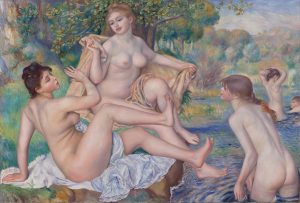Pierre-Auguste Renoir, The Great Bathers, 1884 – 1887, oil on canvas, 46 3/8″ x 67 1/4″. The Mr. and Mrs. Carroll S. Tyson, Jr., Collection, 1963. Image courtesy of Philadelphia Museum of Art, 2019.
The Great Bathers
“For three years Renoir wrestled with this work,” notes Jennifer Thompson, the museum’s Gloria and Jack Drosdick Curator of European Painting and Sculpture and Curator of the John G. Johnson Collection, who organized the exhibition. “Just how exhaustively, we knew from notes left by Berthe Morisot, but seeing the cross-sections and X-rays taken by our specialists in Conservation has reaffirmed precisely how much he questioned himself and started over, again and again.”
The Great Bathers, Renoir’s post-impressionist masterwork, has just completed a year long restoration, there were shifts in the paint layers that caused shadows on the surface and an old layer of yellowed varnish from a 1940s restoration effort was removed, now the large oil painting glows with the color and light the artist experienced during its creation. The gallery displays a chip of paint that reveals the layers of color and decision making the artist grappled with to make color do his bidding. The flesh painting is lively, dewey, and warm, colors built up over time, layer on layer of colors and white paint; purples, oranges, ochres, are glazed and smoothed with descriptive brushstrokes until the surface of the canvas is structurally, satisfyingly colorful, optically stealthy and atmospherically rich, and texturally, sensually appealing.
Forms wrapped in color fold and twist into space, the shapes and connections resolve into multi-colorful passages of imagination, observation, and meditation, Renoir understands color as a communication device. The contrast of flesh painting, the figures, against landscape painting elements like water, sky, and foliage, is expressively explained with hue and tones from his limited color palette, luscious chords of viridian, cobalt, and warm venetian red describe the landscape atmospherics eloquently; layers of paint, glaze, and pigment are orchestrated with virtuoso brush strokes, color mixtures, and patient periods of thought and time are layers of intellect and genius like an allusive glint of light in peripheral vision.
The painting is squirmy, squishy, wet and warm, the allure of primitiveness, Nature, and the Elements, are narrated with arabesque lines, atmospheric light, and coded color broken into a taxonomic description of painterly skills and problem solving, exploration of shapes in space, and exquisite color and light development. By folding space, time, color, light, line, and shape into a unified, multifaceted holographic explanation of life, the artist speaks in a language without words, color provides the answer to all of the questions. The shifting orthogonal planes are built from layers of color, not a mix on the palette, but the physical gesture of paint application and the temporal Mobius strip of time twisting through the construct like a color form of its own making.
by DoN
The Impressionist’s Eye at The Philadelphia Museum of Art, April 16th – August 18th, 2019
Curator
Jennifer Thompson, the Gloria and Jack Drosdick Curator of European Painting and Sculpture and Curator of the John G. Johnson Collection
Social Media
Twitter/Facebook/Instagram/Tumblr/YouTube: @philamuseum
Like DoNArTNeWs Philadelphia Art News Blog on facebook
Follow DoN on Twitter @DoNNieBeat58
@donniebeat on Instagram
More DoNArTNeWs at www.brewermultimedia.com
Affiliate Marketing Disclosure Statement
Donate via safe and secure PayPal in the sidebar.
DoNArTNeWs celebrating eleven years reporting on Philadelphia art and artists.




{ 0 comments… add one now }
You must log in to post a comment.